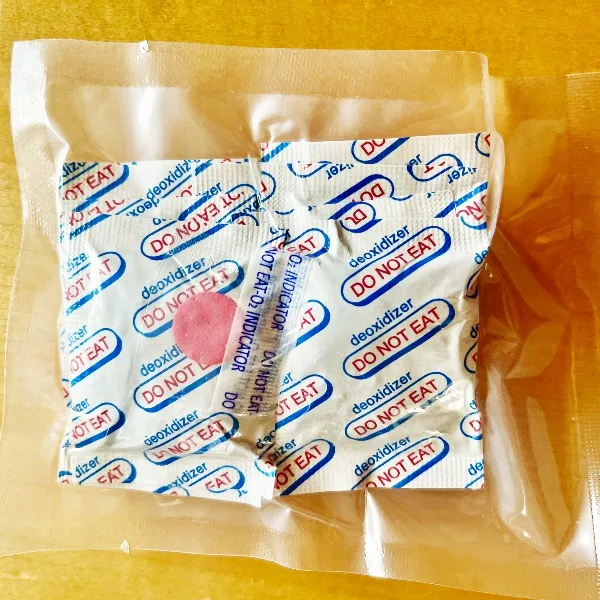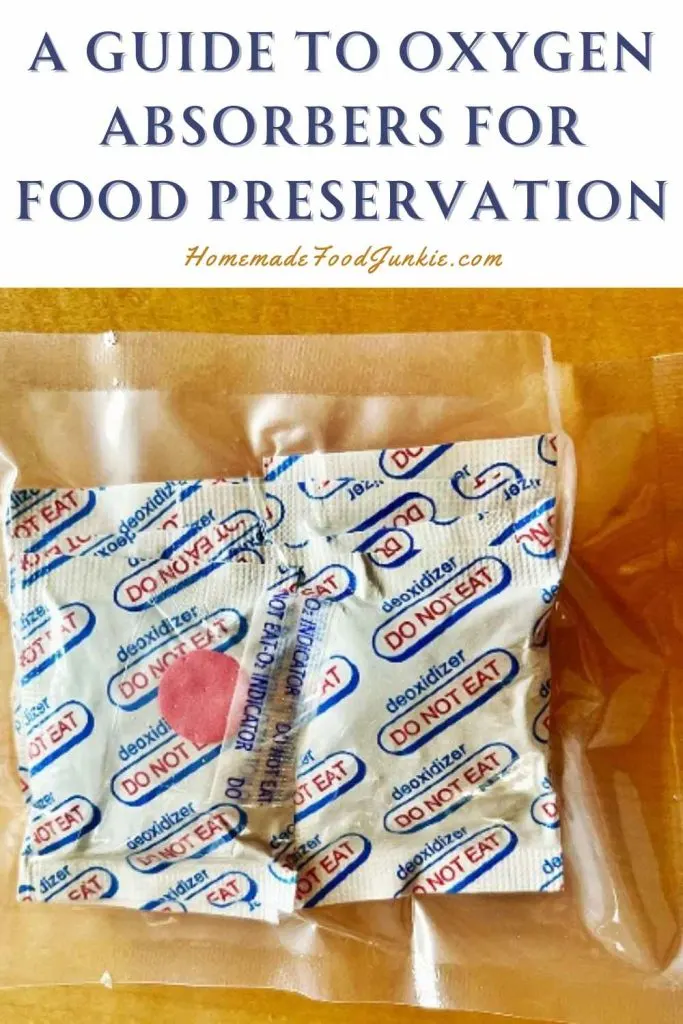Welcome to our informational series on Freeze Drying. This post explains Oxygen absorbers. What they are, how they work and why they NEED to be included in your long term storage equipment for freeze dried goods.
It’s a good idea to use Oxygen absorbers for food storage. They help a great deal to ensure your dry foods stay fresh in storage

What is an Oxygen Absorber? An oxygen absorber, Also Known as oxygen scavengers or O2 absorbers, is a small packet of IRON powder, possibly mixed with salt or charcoal. When Iron powder is exposed to air it absorbs the O2 from the air and creates IRON OXCIDE, this reaction absorbs O2 from the surrounding Air.
They are labeled so you know they remove O2 from the surrounding air. The packets contain iron powder, salt, and an absorbent material of some kind.
The primary purpose of an oxygen absorber is to remove oxygen from air. Food in a sealed environment, such as a food storage container can contain O2 which degrades food in long term storage. Oxygen scavengers will consume that damaging O2 so it can’t impact your dried and freeze dried foods.
Here’s how oxygen absorbers work:
- Activation: When the iron in the packet reacts with oxygen, the reaction forms iron oxide, commonly known as rust. However, the reaction occurs slowly and at a low level, and it doesn’t affect the food itself.
- Absorption of Oxygen: As the iron reacts with oxygen, it absorbs and removes the oxygen from the surrounding environment, effectively reducing the oxygen content within the sealed package.
- Sealed Environment: O2 absorbers are most effective in sealed environments, such as food storage containers or packaging. When used properly, they can improve and extend the shelf life of foods by preventing oxidative processes that lead to food degradation and spoilage.
Here are some reasons why oxygen absorbers are commonly used in freeze-dried food preservation:
- Oxidation Control: Oxygen is a major contributor to oxidation, which causes the breakdown of fats and other sensitive compounds. Oxygen absorbers help create an oxygen-free environment, reducing the risk of oxidation.
- Prevention of Microbial Growth: Oxygen is essential for the growth of aerobic microorganisms, including bacteria and molds. By reducing oxygen levels, oxygen absorbers help inhibit the growth of these microorganisms, contributing to the preservation of food.
- Inhibiting Insect Infestation: Bugs need oxygen to live. Removing O2 will eliminate bugs as a problem in your storage.
- Preservation of Flavor and Aroma: Oxygen contributes to the breakdown of volatile compounds responsible for the flavor and aroma of food. By minimizing oxygen exposure, the original taste and aroma of the freeze-dried food are better preserved.
How are Oxygen absorbers different from silica packets? Silica gel packets remove moisture in packaging. Oxygen absorbers cannot remove moisture, only oxygen. Silica gel is a desiccant that absorbs and holds moisture, preventing the growth of mold, mildew, and the degradation of the food caused by humidity. It’s effective in controlling moisture, but for freeze-dried foods, the primary concern is oxygen since moisture is removed during the freeze drying process. This is why we primarily recommend using O2 absorbers in mylar bags with freeze dried foods for long term storage.
That said, in some cases, both oxygen absorbers and silica gel may be used together to address both moisture and oxygen issues in the same food package. If the climate is highly humid, both may be called for.
Why is oxygen bad for dried food?
Oxygen is bad for dried food, including freeze dried food since O2 contributes to oxidation. Oxidation of stored food will degrade the food’s flavor, color, and nutritional content over time. Here’s how:
- Rancidity: Oxygen causes fats and oils in dried foods to become rancid through the process of lipid oxidation which causes off-flavors and odors. This makes stored dried foods unpalatable.
- Nutrient Loss: Oxygen also degrades certain vitamins and antioxidants present in dried foods. This can lead to a reduction in nutritional value over time.
- Color Changes: Oxidized foods undergo changes in the color of fruits and vegetables like turning brown and unappetizing. This is a clue that your stored foods have oxidized and are no longer at prime nutritional value and also they may have gone bad. More on this further into the post.
When we store freeze dried foods we add a properly sized oxygen absorber or two, as needed, to prevent oxidation during long term storage. Oxygen scavengers extend the shelf life of dried foods and maintain their quality. So does using proper storage methods.
Store your freeze dried foods in airtight containers away from light and moisture to help prevent oxidization and improve fresh qualities of your long term stored freeze dried food and other dry goods you may store, such as wheat berries, flours, rice, beans and pasta..
How do you use Oxygen absorbers?
What size O2 absorber do you need? This is an imperfect science. There are many variables that play into how much O2 is in a bag full of food. Different foods have different amounts of oxygen stored in them naturally and in the freeze dried state.
Tips For choosing the correct O2 size for your Mylar bag:
The packets are labeled with a specific capacity to absorb oxygen. Use the appropriate size and quantity for the volume of the sealed container so the packet can do its best work for you. For long term storing freeze dried foods, the details such as O2 packet size matter.
Look at the O2 absorber packet. The Oxygen Absorber is labeled for the volume of O2 they will consume before exhausted. Most often they are labeled in CCs. This is amount of O2 volume the packet can remove before it is used up.
Most mylar bags are labeled in ML volume. Fortunately, ML and CC are interchangeable for our purposes. You can use an O2 absorber that is labeled in CC as the same volume as a ML weight on the bag.
Here’s the formula to figure out the minimum O2 size packet for your Mylar bag of food. CC or ML (volume) /5 = 20% of the volume of the bag. This is a general rule of thumb that you can use to determine if your packet will absorb enough O2 to do the job.
You cannot OVERDO the O2 packet size. When in doubt, use an extra packet. The O2 absorbers will continue to absorb O2 throughout the life of your bag and even help mitigate a tiny leak or hole over time, if the absorber still has some absorbency left in it. So err on the high, not low side of the equation.
300 CC O2 absorber work well for a quart size (8 x 12) mylar bag. So scale up the O2 packet absorption number for larger bags as needed, or add more packets as necessary to provide the proper amount of absorption.
For Other containers, here are the recommended O2 absorber sizes:
This table provides a quick reference for the recommended sizes of O2 absorbers for various sizes of Mason jars, metal containers or food grade, well sealed plastic buckets.
| Container Size | Recommended O2 Absorber Size |
|---|---|
| 1/2 Pint | 50 cc |
| 1 Pint | 100 cc |
| Quart | 200 cc |
| 1/2 Gallon | 400 cc |
| 1 Gallon | 800 cc |
| 5 Gallon | 2500 cc |
Steps for Using an Oxygen Absorber:
How To Tell If your O2 packets are good to use?
- Pliable. An exhausted O2 scavenger bag will be hard.
- A working O2 absorber is warm to touch.
- Indicator in bag is PINK. Purple means no go.
NOTE: O2 absorbers are not meant to be used with fresh or moist foods. They are for dry goods storage only. Moisture will interfere with their effectiveness.
Using an oxygen absorber is a straightforward process. Here’s a step-by-step List:
- Select the Right Size: Choose an oxygen absorber packet appropriate for the volume of the container you are using. The absorber size is typically determined by the container’s cubic footage or CC (ML) size as discussed in the previous section.
- Prepare Your Container: Ensure that the container you are using is clean and airtight and DRY. ANY MOISTURE in the container will rehydrate your food and cause it to spoil, even tiny drops. The container can be glass, metal, or a thick opaque, plastic container with an airtight seal.
- Place Food Inside: Fill your container with the food you want to store. Make sure the food is dry, as moisture can interfere with the absorption process.
- Insert the Oxygen Absorber: Place the oxygen absorber packet into the container with the food. It’s crucial to work quickly to minimize exposure to air.
- Seal the Container: Immediately seal the container tightly to prevent additional air from entering. Use a vacuum sealer, chamber sealer, jar sealer or any other method that ensures an airtight seal.
- Label and Date: Label the container with the contents and the date of packaging. This helps you keep track of freshness.
- Store in a Cool, Dark Place: Store the sealed container in a cool, dark place. This further extends the shelf life of the food.
Why is my bag still full of air? O2 absorbers do NOT remove all of the air in the mylar bag of dried food. It only removes the OXYGEN out of the air. O2 only makes up about 20% of the total volume of air in the bag. So press out as much air as you can before sealing.
How to store leftover O2 Bags:
How long are Oxygen absorbers good out of the package? O2 absorbers begin to react with oxygen right away once opened. It’s best to use your O2 absorbers IMMEDIATELY after opening them. Do NOT let them sit open to air while your getting ready to package. To protect your O2 packets repackage them in an air tight container, like a sealed mason jar, or heat seal the bag they are in within 15 minutes of opening. this will keep them fresh and charged.
Here’s more tips on protecting your O2 Packets in storage:
- Keep in a Cool and Dry Place: Store the leftover oxygen absorber packets in a cool, dry place away from direct sunlight. Exposure to heat and moisture can activate the absorbers prematurely, reducing their effectiveness.
- Use Airtight Containers: Place the oxygen absorber packets in airtight containers, such as glass jars or plastic containers with tight-sealing lids. This prevents them from absorbing moisture from the air.
- Avoid Exposure to Air: Minimize the exposure of the oxygen scavengers to air when handling them. Work quickly and reseal the storage container promptly after use.
- Use Desiccant Silica Packs: Consider adding desiccant packs (silica gel packets) to the storage container to absorb any residual moisture. This extra step helps maintain the dry environment necessary for optimal oxygen absorber performance.
- Label and Date: Clearly label the storage container with the date of purchase and any other relevant information. This helps you keep track of the absorbers’ age and ensures that you use the oldest ones first.
- Rotate Stock: If you have a large quantity of oxygen absorbers, practice a “first in, first out” (FIFO) system. This means using the oldest absorbers first to ensure that none of them expire before use.
- Avoid Cross-Contamination: Store O2 Absorbers away from strong-smelling or potentially contaminating substances. These packets can absorb odors, so keeping them in a clean and odor-free environment is essential.
- Re-Seal Original Packaging: If the oxygen scavengers come in a resealable bag, use it to store the remaining packets. Squeeze out excess air before sealing to maintain a low-oxygen environment. Then Heat seal the bag shut. you can also toss the packets in a mason jar and use a jar sealer to seal the lid tight.
- Inspect Regularly: Periodically check the stored oxygen scavengers for signs of activation, such as hardness. If they feel hard or crunchy, they have been exposed to moisture and are less effective.
What are silica packets? How are they different? Silica Packets remove MOISTURE only. O2 absorbers remove oxygen ONLY. O2 bags only work will FULLY dried food with zero moisture. For this reason, some people choose to combine silica gel packs with O2 packets in their food storage.
Best Containers for Long-Term Storage with Oxygen Absorbers:
O2 absorbers work best when used with containers that provide an excellent barrier against oxygen and moisture. Here are some recommended container options:
- Mylar Bags: These are durable, flexible bags with excellent oxygen and moisture barrier properties. Mylar bags are lined with aluminum to prevent moisture and O2 exchange into the bag. Use with oxygen scavengers for long-term food storage.
- Vacuum-Sealed Mylar Bags: Ideal for removing excess air before sealing, vacuum-sealed bags help maximize the efficiency of O2 absorbers. Vacuum chambers are even better but more expensive.
- Glass Jars: Mason canning glass jars with airtight seals provide a good barrier against oxygen when a jar sealer is used to seal the lid. Freeze dried foods last about a year, sometimes longer in a well sealed Mason jar kept in a cool, dark, dry place.
- Metal Containers: Aluminum or steel containers with a secure seal are effective at keeping out oxygen and light.
- Food-Grade Plastic Buckets: Thick, food-grade plastic buckets with airtight lids are suitable for storing bulk quantities of food when used with O2 absorbers.
Remember that the key to successful long-term storage is eliminating moisture and Oxygen from the storage container. By combining oxygen absorbers with containers that provide an excellent barrier against oxygen, light, and moisture your food will last and retain its best quality.
FINALLY: Are These Oxygen scavengers toxic to dogs? Yes. Keep your dogs away from oxygen absorbers. Find out more about the toxicity of O2 Absorbers to dogs here

